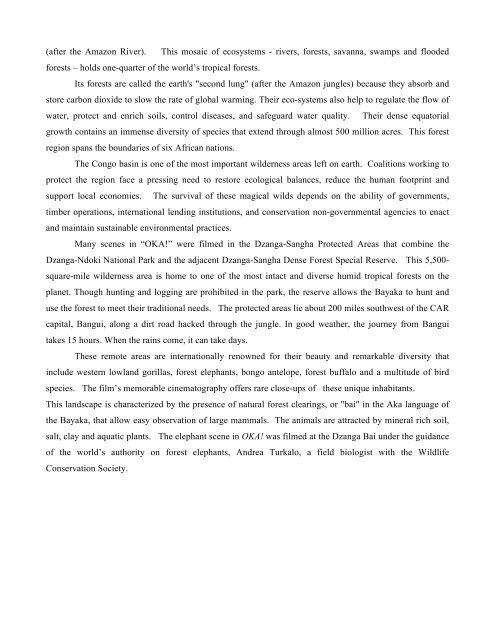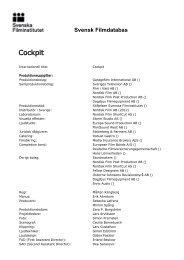A film by Lavinia Currier Based on the memoir by Louis ... - FDb.cz
A film by Lavinia Currier Based on the memoir by Louis ... - FDb.cz
A film by Lavinia Currier Based on the memoir by Louis ... - FDb.cz
Create successful ePaper yourself
Turn your PDF publications into a flip-book with our unique Google optimized e-Paper software.
(after <strong>the</strong> Amaz<strong>on</strong> River). This mosaic of ecosystems - rivers, forests, savanna, swamps and flooded<br />
forests – holds <strong>on</strong>e-quarter of <strong>the</strong> world’s tropical forests.<br />
Its forests are called <strong>the</strong> earth's "sec<strong>on</strong>d lung" (after <strong>the</strong> Amaz<strong>on</strong> jungles) because <strong>the</strong>y absorb and<br />
store carb<strong>on</strong> dioxide to slow <strong>the</strong> rate of global warming. Their eco-systems also help to regulate <strong>the</strong> flow of<br />
water, protect and enrich soils, c<strong>on</strong>trol diseases, and safeguard water quality. Their dense equatorial<br />
growth c<strong>on</strong>tains an immense diversity of species that extend through almost 500 milli<strong>on</strong> acres. This forest<br />
regi<strong>on</strong> spans <strong>the</strong> boundaries of six African nati<strong>on</strong>s.<br />
The C<strong>on</strong>go basin is <strong>on</strong>e of <strong>the</strong> most important wilderness areas left <strong>on</strong> earth. Coaliti<strong>on</strong>s working to<br />
protect <strong>the</strong> regi<strong>on</strong> face a pressing need to restore ecological balances, reduce <strong>the</strong> human footprint and<br />
support local ec<strong>on</strong>omies. The survival of <strong>the</strong>se magical wilds depends <strong>on</strong> <strong>the</strong> ability of governments,<br />
timber operati<strong>on</strong>s, internati<strong>on</strong>al lending instituti<strong>on</strong>s, and c<strong>on</strong>servati<strong>on</strong> n<strong>on</strong>-governmental agencies to enact<br />
and maintain sustainable envir<strong>on</strong>mental practices.<br />
Many scenes in “OKA!” were <str<strong>on</strong>g>film</str<strong>on</strong>g>ed in <strong>the</strong> Dzanga-Sangha Protected Areas that combine <strong>the</strong><br />
Dzanga-Ndoki Nati<strong>on</strong>al Park and <strong>the</strong> adjacent Dzanga-Sangha Dense Forest Special Reserve. This 5,500-<br />
square-mile wilderness area is home to <strong>on</strong>e of <strong>the</strong> most intact and diverse humid tropical forests <strong>on</strong> <strong>the</strong><br />
planet. Though hunting and logging are prohibited in <strong>the</strong> park, <strong>the</strong> reserve allows <strong>the</strong> Bayaka to hunt and<br />
use <strong>the</strong> forest to meet <strong>the</strong>ir traditi<strong>on</strong>al needs. The protected areas lie about 200 miles southwest of <strong>the</strong> CAR<br />
capital, Bangui, al<strong>on</strong>g a dirt road hacked through <strong>the</strong> jungle. In good wea<strong>the</strong>r, <strong>the</strong> journey from Bangui<br />
takes 15 hours. When <strong>the</strong> rains come, it can take days.<br />
These remote areas are internati<strong>on</strong>ally renowned for <strong>the</strong>ir beauty and remarkable diversity that<br />
include western lowland gorillas, forest elephants, b<strong>on</strong>go antelope, forest buffalo and a multitude of bird<br />
species. The <str<strong>on</strong>g>film</str<strong>on</strong>g>’s memorable cinematography offers rare close-ups of <strong>the</strong>se unique inhabitants.<br />
This landscape is characterized <str<strong>on</strong>g>by</str<strong>on</strong>g> <strong>the</strong> presence of natural forest clearings, or "bai" in <strong>the</strong> Aka language of<br />
<strong>the</strong> Bayaka, that allow easy observati<strong>on</strong> of large mammals. The animals are attracted <str<strong>on</strong>g>by</str<strong>on</strong>g> mineral rich soil,<br />
salt, clay and aquatic plants. The elephant scene in OKA! was <str<strong>on</strong>g>film</str<strong>on</strong>g>ed at <strong>the</strong> Dzanga Bai under <strong>the</strong> guidance<br />
of <strong>the</strong> world’s authority <strong>on</strong> forest elephants, Andrea Turkalo, a field biologist with <strong>the</strong> Wildlife<br />
C<strong>on</strong>servati<strong>on</strong> Society.

















